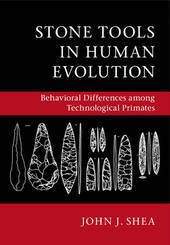
|
Stone Tools in Human Evolution: Behavioral Differences among Technological Primates
Hardback
Main Details
| Title |
Stone Tools in Human Evolution: Behavioral Differences among Technological Primates
|
| Authors and Contributors |
By (author) John J. Shea
|
| Physical Properties |
| Format:Hardback | | Pages:306 | | Dimensions(mm): Height 260,Width 182 |
|
| Category/Genre | Prehistoric archaeology |
|---|
| ISBN/Barcode |
9781107123090
|
| Classifications | Dewey:930.1 |
|---|
| Audience | | Tertiary Education (US: College) | | Professional & Vocational | |
|---|
| Illustrations |
26 Tables, black and white; 2 Halftones, black and white; 49 Line drawings, black and white
|
|
Publishing Details |
| Publisher |
Cambridge University Press
|
| Imprint |
Cambridge University Press
|
| Publication Date |
7 November 2016 |
| Publication Country |
United Kingdom
|
Description
In Stone Tools in Human Evolution, John J. Shea argues that over the last three million years hominins' technological strategies shifted from occasional tool use, much like that seen among living non-human primates, to a uniquely human pattern of obligatory tool use. Examining how the lithic archaeological record changed over the course of human evolution, he compares tool use by living humans and non-human primates and predicts how the archaeological stone tool evidence should have changed as distinctively human behaviors evolved. Those behaviors include using cutting tools, logistical mobility (carrying things), language and symbolic artifacts, geographic dispersal and diaspora, and residential sedentism (living in the same place for prolonged periods). Shea then tests those predictions by analyzing the archaeological lithic record from 6,500 years ago to 3.5 million years ago.
Author Biography
John J. Shea is Professor of Anthropology at State University of New York, Stony Brook. He is the author of Stone Tools in the Paleolithic and Neolithic Near East: A Guide (2013) and co-editor of Out of Africa 1: The First Hominin Colonization of Eurasia (2010). Shea is also an expert flintknapper whose demonstrations of stone tool production and other ancestral technology skills appear in numerous television documentaries and in the National Museum of Natural History, Washington DC, as well as in the American Museum of Natural History, New York City.
Reviews'A useful counterbalance to hidebound Paleolithic systematics, Stone Tools in Human Evolution implements a better-grounded descriptive approach. It shows a way forward and therefore deserves close study.' Current Anthropology 'Designed for a readership of upper-division college and first-year archaeology graduate students (with 'boxes', plenty of line drawings, and a glossary of terms), but with a distinct message for all those who think about and research human evolution - biological and cultural - this interesting book has a valuable message. It is full of thought-provoking and sometimes provocative ideas.' Journal of Anthropological Research
|